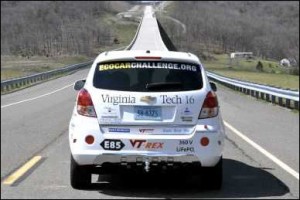by James A. Bacon
Tom Dingus has done as much as anyone to advance vehicle automation and the advent of self-driving cars. Many of the automated features found in automobiles today — automated braking, active cruise control, rear-view cameras — were tested at the Virginia Tech Transportation Institute, where he serves as director. But Dingus is cautious about predicting the imminent arrival of self-driving cars.
Estimates range from three years to thirty for how long it will take before self-driving cars dominate the road, he told the Governor’s Transportation Conference yesterday. He would lean toward the thirty-year estimate, he said.
Automated cars are excellent at dealing with routine situations. If the car ahead jams on its brakes, the automated car will respond more quickly than the typical human could. But most traffic fatalities don’t occur in routine situations, Dingus said. They occur in “anomalous,” or unusual, situations for which cars have not been programmed to respond. “You have to solve real-world problems.” And that takes time.
Despite the challenges, Dingus said, connected vehicles — vehicles that communicate data with each other and the road infrastructure — potentially could eliminate 70% of all crashes.
Virginia is in the vanguard of research on vehicle automation and connected vehicles. The Virginia Tech Transportation Institute is recognized as a national leader, having forged partnerships with leading technology and automotive companies, that generates millions of dollars in research contracts annually. The state’s Transportation Research Council, which does work on smart infrastructure, also is highly regarded nationally. Virginia Automated Corridors on Interstate 66 and Interstate 495 provide real-world “test beds” for both connected vehicles and smart infrastructure.
Meanwhile, Virginia Department of Transportation (VDOT) personnel are taking active part in an American Association of State Highway and Transportation Officials (AASHTO) coalition that is studying connected vehicles, and VDOT is the lead funder in a pool-funded research initiative geared to move connected-vehicles from research to pilot projects and testing.
The emphasis on smart technology, said Virginia Highway Commissioner Charlie Kilpatrick is part of a larger shift in thinking at VDOT. For decades the department had a civil engineering mindset that its jobs was to build bridges and roads. “Our job is not about building bridges and roads,” he said. “It’s about moving people.”
VDOT sees the potential to use technology to improve system performance — reducing accidents, improving safety and increasing reliability, said Dean Gufstafson, state operations engineer. And the department is asking lots of new questions: What will the future of transportation look like? What investments does VDOT have to make? What is the role of government?
Catherine McGhee, VDOT’s safety chief, described how connected vehicles could work with connected infrastructure to make roads safer for public servants who work in and near the roads — construction workers, state police, emergency service personnel. A state trooper can carry a device that alerts cars when he’s on the side of the road so that cars will switch lanes. Similarly, a road worker can wear a vest that informs cars when he steps beyond the traffic cones.
Virginia had 700 traffic fatalities last year, said McGhee. That’s too many. And the new technologies can make a big difference.



